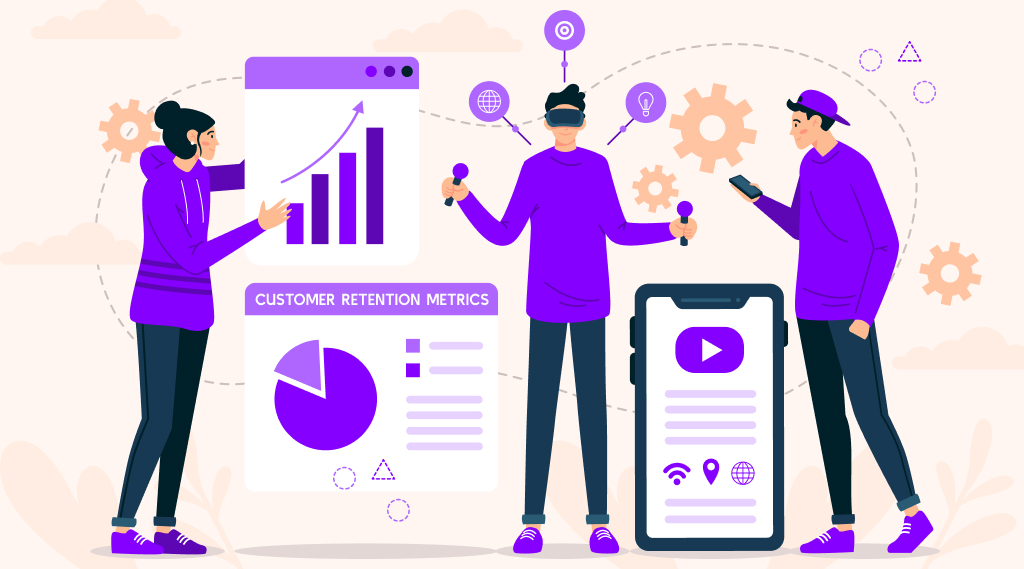Introduction
In SaaS, customer retention metrics hold the key to sustained growth and success. As we step into 2024, it’s more crucial than ever for SaaS brands to understand and ace the game of customer retention.
So, let’s break it down. In this guide, we’re going to explore the top 11 customer retention metrics that SaaS companies should track in 2024. Think of them as your secret code to keeping customers hooked and your business booming.
By delving into these metrics, SaaS businesses can gain invaluable insights into customer behavior, satisfaction levels, and ultimately, drive strategies for long-term retention and growth. Ready to dive into SaaS customer retention? Let’s go!
What are customer retention metrics?
Customer retention metrics are quantitative measurements used to assess the effectiveness of a business in retaining its existing customers over a specific period. These metrics provide insights into customer loyalty, satisfaction, and the overall health of customer relationships.
At its core, customer retention metrics consists of various key performance indicators (KPIs) that reflect the extent to which customers continue to use a product or service, renew subscriptions, and advocate for the brand. These metrics go beyond mere transactional data and delve into the depth of the customer relationship, shedding light on factors like churn rate, customer lifetime value (CLV), and renewal rates.
Understanding customer retention metrics empowers SaaS businesses to identify areas of improvement, address pain points, and tailor their offerings to better meet customer needs. By analyzing these metrics comprehensively, companies can develop proactive retention strategies, enhance customer experience, and ultimately promoting long-lasting relationships with their clientele.
Why are customer retention metrics important for SaaS companies?
Customer retention metrics serve as the compass guiding SaaS companies through the concept of customer relationships. In this section, we’ll delve into why customer retention metrics are indispensable for SaaS companies, explaining their pivotal role in driving growth, promoting loyalty, and ensuring sustained success.
Here’s why customer retention metrics are important for SaaS companies:
- Subscription-based revenue model
- High acquisition costs
- Long-term customer value
- Competitive landscape
- Product development and innovation
- Customer advocacy and referrals
- Operational efficiency
- Data-driven decision-making
Let’s look into each of the above reasons in brief:
1. Subscription-based revenue model
SaaS companies typically operate on a subscription-based revenue model. Customer retention directly impacts recurring revenue, making it essential to monitor metrics such as churn rate and renewal rates to ensure a stable and predictable revenue stream.
2. High acquisition costs
Acquiring new customers in the SaaS industry often involves significant marketing and sales expenditures. Emphasizing customer retention helps maximize the return on investment (ROI) of these acquisition costs by keeping existing customers engaged and satisfied.
3. Long-term customer value
SaaS companies derive substantial value from long-term customer relationships. Metrics like [Customer Lifetime Value (CLV)] provide insights into the overall revenue a customer is likely to generate during their tenure, guiding strategic decisions for customer engagement and loyalty.
4. Competitive landscape
The SaaS industry is highly competitive, with numerous alternatives available for customers. Effective customer retention strategies differentiate a company from its competitors, promoting brand loyalty and reducing the risk of customers migrating to other solutions.
5. Product development and innovation
Customer feedback and retention metrics are invaluable for informing product development and innovation. Understanding customer needs and preferences enables SaaS companies to enhance their offerings, providing continuous value and reducing the likelihood of customers seeking alternatives.
6. Customer advocacy and referrals
Satisfied and loyal SaaS customers can become powerful advocates, leading to referrals and positive word-of-mouth. Metrics such as Net Promoter Score (NPS) and referral rates gauge the level of customer advocacy, contributing to organic growth and new customer acquisition.
7. Operational efficiency
Efficient customer retention strategies contribute to operational efficiency. A focus on retaining existing customers reduces the need for continuous aggressive acquisition efforts, allowing resources to be allocated more strategically and cost-effectively.
8. Data-driven decision-making
SaaS companies thrive on data-driven decision-making. Customer retention metrics provide quantifiable insights into the effectiveness of strategies, allowing companies to iterate and optimize their approaches based on real-time data.
In summary, the importance of customer retention metrics for SaaS companies cannot be overstated. From ensuring revenue stability and cost-efficient growth to nurturing strong customer relationships and gaining a competitive edge, these metrics strengthen every aspect of a SaaS company’s success.
Top 11 customer retention metrics you’ll want to analyze for your SaaS business
As a SaaS business owner, understanding and analyzing customer retention metrics is crucial for long-term success.
Here are the top 11 customer retention metrics you’ll want to delve into:
- Churn rate
- Customer Lifetime Value (CLV)
- Monthly Recurring Revenue (MRR) churn
- Net revenue retention
- Customer Satisfaction Score (CSAT)
- Net Promoter Score (NPS)
- Customer Retention Cost (CRC)
- Renewal rate
- Upsell and cross-sell rates
- Customer health score
- Customer effort score (CES)
Let’s look into each of the above metrics in brief:
1. Churn rate
Churn rate measures the percentage of customers who stop using your service over a specific period. Tracking churn helps identify trends and areas for improvement in your product or service.
Formula: Churn rate = (number of customers churned / total number of customers) * 100
2. Customer lifetime value (CLV)
CLV estimates the total revenue a customer will generate throughout their relationship with your business. By understanding CLV, you can allocate resources effectively and focus on retaining high-value customers.
Formula: CLV = average purchase value × average purchase frequency rate × average customer lifespan
3. Monthly recurring revenue (MRR) churn
MRR churn calculates the revenue lost due to customers canceling their subscriptions. It provides insights into revenue trends and helps assess the impact of churn on your business’s financial health.
Formula: MRR churn = sum of MRR lost due to churned customers
4. Net revenue retention
Net revenue retention measures the growth in revenue from existing customers, accounting for both expansion and churn. A high net revenue retention rate indicates that your business is effectively upselling and retaining customers.
Formula: Net revenue retention = ((revenue from expansions + revenue from upsells) – revenue lost from churned customers) / revenue at the beginning of the period
5. Customer satisfaction score (CSAT)
CSAT measures how satisfied customers are with your product or service. Regularly surveying customers for feedback allows you to identify areas for improvement and gauge overall satisfaction levels.
Formula: CSAT = (sum of Individual satisfaction ratings) / (total number of respondents)
6. Net promoter score (NPS)
NPS measures customer loyalty and likelihood to recommend your business to others. Promoters are your loyal advocates, while detractors may indicate areas of dissatisfaction that need addressing.
Formula: NPS = percentage of promoters – percentage of detractors
7. Customer retention cost (CRC)
CRC calculates the expenses incurred to retain customers, providing insights into the efficiency of retention strategies. It helps in optimizing the balance between investment and retention outcomes.
Formula: CRC = total costs related to customer retention efforts / number of retained customers
8. Renewal rate
Renewal rate tracks the percentage of customers who renew their subscriptions at the end of their contract term. Monitoring renewal rates helps identify factors influencing customer decisions to renew or churn.
Formula: Renewal rate = (number of renewed customers / total number of customers up for renewal) * 100
9. Upsell and cross-sell rates
These metrics measure the percentage of customers who upgrade to higher-tier plans or purchase additional products or features. Effective upselling and cross-selling can increase customer lifetime value and revenue.
Formula: Upsell/cross-sell rate = (number of customers who upsell/cross-sell / total number of customers) * 100
10. Customer health score
A customer health score consolidates various indicators like product usage, support ticket history, and engagement levels. It offers a holistic view of a customer’s relationship with the product and helps predict potential churn.
Formula: Combine multiple factors (e.g., usage frequency, support interactions) to create a composite health score.
11. Customer Effort Score (CES)
CES evaluates how easy or difficult it is for customers to achieve their goals using a product. Lower customer effort scores indicate a more seamless user experience, contributing to higher satisfaction and retention.
Formula: Ask customers about the ease of accomplishing tasks or resolving issues on a scale.
By analyzing these customer retention metrics regularly, you can gain valuable insights into your SaaS business’s performance, identify areas for improvement, and implement strategies to enhance customer retention and loyalty.
Conclusion
For Software as a Service (SaaS) businesses, the significance of customer retention metrics cannot be overstated. As businesses strive to not only acquire customers but also retain them for the long haul, analyzing these metrics becomes imperative. Through this comprehensive guide, we’ve explored the essence of customer retention metrics, delved into their importance for SaaS companies, and outlined the top 11 metrics to track in 2024.
Moreover, we’ve discussed how to effectively measure and interpret these metrics, empowering SaaS businesses to make data-driven decisions and take proactive steps toward enhancing customer retention. By leveraging the power of customer retention metrics, SaaS companies can cultivate stronger customer relationships, promoting loyalty, and position themselves for long-term success in an increasingly competitive market.
As we look ahead to the future of SaaS in 2024 and beyond, one thing remains clear: prioritizing customer retention is essential for achieving sustained growth, profitability, and customer satisfaction. By embracing a customer-centric approach and harnessing the insights provided by these metrics, SaaS businesses can navigate challenges and seize opportunities. Start optimizing your customer retention strategy now! Contact us today!

